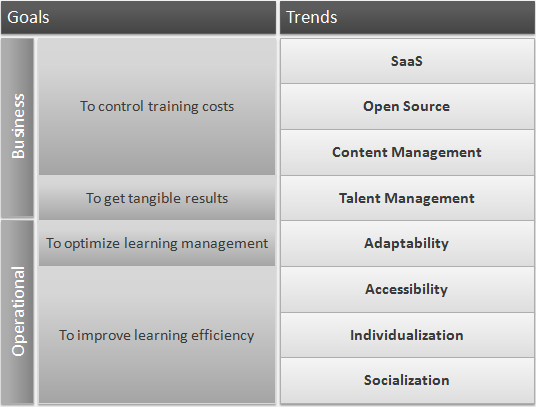Background
All through 2010, we interviewed LMS vendors about the way they considered the LMS market and about their positioning on it. As a result, 22 interviews transcribed both in French and English and freely accessible on this blog.
In a second step, we analyzed the collected answers. They resulted, to our minds, in 8 major standing-out trends which we shall sum up hereafter and illustrate with numerous testimonials.
Change drivers
The 8 trends observed are not the result of chance. They demonstrate the vendors’ effort to adjust their offer to the organizations expectations, expectations that we shall separate into 2 categories: business ones and operational ones.
Business expectations
The business expectations, expressed by decision-makers, are motivated by Returns On Investment (ROI) and impacts on business, trying, on the one hand, to control the costs related to training and, on the other hand, to get tangible results for the organization.
In these tough times, training budgets and value are more important than ever. The challenge for L&D here is simple: are you focused on organizational impact? That is what your executives want. (…) They want to know that L&D is having a positive impact on their business priorities at a reasonable cost. —–Maria van Vlodrop, CertPoint
Operational expectations
The operational expectations, expressed by training players, aim at optimizing learning management at all the organization levels and at improving learning efficiency.
By effective they are looking at delivering learning content in a personalized mode based upon role and knowledge level as well as in multiple formats, such as instructor-led, elearning, documentation, performance support, and mobile. —–Bas Kramer, OutstartThe 8 LMS trends
The table below presents the 8 LMS trends observed with reference to the organizations expectations.

Shortcuts: Introduction | SaaS | Open Source | Content Management | Talent Management | Adaptability | Accessibility | Individualization | Socialization | Special Thanks



